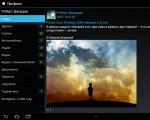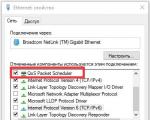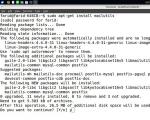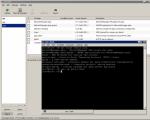Windows 10 lock screen image Windows: Interesting (Spotlight) not working - solution. Through task creation
The lock screen is one of the few visual components that Windows 10 inherited from previous version systems without undergoing major changes. As a purely cosmetic addition to the login screen, the lock screen does not carry much functionality, and therefore can be disabled without any consequences for Windows.
There are two ways to disable the lock screen in Windows 10: using the local editor group policies and by editing the registry. The second method is useful if the policy editor is not available in your version of the system.
Method one
Press Win + R and run the gpedit.msc command in the window that opens, and then in the left column of the editor window, sequentially expand the following items of the tree-like list of parameters:
Computer Configuration -> Administrative Templates -> Control Panel -> Personalization

Accordingly, in English version"Tens" it will look like this:
Computer Configuration -> Administrative Templates -> Control Panel -> Personalization
Now find the option "Do not display the lock screen" on the right side of the window and double-click on it. In the opened window for changing the parameters, switch the radio button from the "Not configured" position to the "Enabled" position and save the new settings.

It's all. You can check the result by pressing the combination Win + L.
Method two
Use the regedit command to open the registry editor and follow the chain:
HKEY_LOCAL_MACHINE / SOFTWARE / Policies / Microsoft / Windows / Personalization
In the last subsection, you need to create a new 32-bit NoLockScreen DWORD parameter and set its value to 1. (If the Personalization subsection does not exist, create it manually).

The changes should take effect immediately, but it is quite possible that you still need to restart your computer.
Update from 08/03/2016
For Windows 10 Anniversary 1607 users
As you probably already know, in the home and professional editions, Microsoft developers have removed the function to disable the screen lock. Now, if you want to disable this component for yourself, you will have to work around it. Fortunately, this procedure is simple and does not take much time.
Note: a new version Windows 10 does not allow you to disable the lock screen completely. Both methods, which will be discussed below, allow you to prevent the display of the lock screen when you wake up from sleep mode and after locking the system by pressing the Win + L keys. Unfortunately, you cannot prevent the appearance of the lockscreen when you turn on or after restarting computers.
The easy way
Go to C: \ Windows \ SystemApps and rename the folder Microsoft.LockApp_cw5n1h2txyewy... You can simply add any character (exclamation mark, for example) to the original folder name. Renaming requires administrator rights.

Renaming shouldn't entail any undesirable consequences, but if you still prefer to avoid any manipulation with system folders, then the second method will suit you.
The method is more complicated, but 100% safe
Use the taskschd.msc command to open the Task Scheduler, select the scheduler library with the mouse and click the "Create task" link in the right column. In the window that opens, in the "General" tab, specify the name of the task, in the security settings, select the "Run with highest rights" checkbox, and in the "Configure for" drop-down menu, select Windows 10. Now switch to the "Triggers" tab and click "Create ".
Next, in the trigger creation window in the Start task menu, select At login, and at the same time make sure that the Any user and Enabled settings are active. Click OK. Create another trigger in the same way, only this time from the Start Task menu select the On Workstation Unlocked option. After that, go to the "Actions" tab, click "New", in the field of the "Program or script" window that opens, enter reg.exe, and in the "Add arguments" field, enter the following command:
Add HKLMSOFTWARE / Microsoft / Windows / CurrentVersion / Authentication / LogonUI / SessionData / t REG_DWORD / v AllowLockScreen / d 0 / f
By turning on the computer, the user is planning to do a lot of things. Therefore, it is important for him to quickly get all the necessary information from various applications even before logging into the system. The Windows 10 lock screen will help provide this information, as well as provide primary protection for your computer.
What is Windows 10 lock screen
At startup operating system the first thing you see is the lock screen. This is a window where you can get some information from applications against a beautiful background. The lock window has the following features:
- shows time, weather and other information from applications; what information will be displayed in this window depends on the specific settings;
- provides primary protection of the system - to enter, you must enter a password in the lock window;
- allows you to customize the wallpaper of the window itself, including making an automatic change of images; bright and nice-looking picture on the lock screen will help the user to tune in to a pleasant working day.
The lock screen is present initially in each Windows system 10. Therefore, the only question is how to set it up correctly.
How to customize the Windows 10 lock screen
The lock screen has quite flexible settings that allow you to make it comfortable to work with, and also have good tools for customizing its appearance. And, of course, you can simply turn off the lock screen if necessary.
Turn on the lock screen
The lock screen in Windows 10 is always on by default. You can enable the lock screen pattern as follows:
After completing these steps, the lock screen will work as expected and will return to it. background picture.
Video: Customize your lock screen and personalize
Image change
You can install absolutely any images on your lock screen. Someone sets there photographs of loved ones, others put beautiful views nature. And this setting is performed in the following way:
- Navigate to the Personalization Settings menu via Windows Options.
Go to the personalization menu via Windows settings
- Go to the lock screen settings section and click “Browse” under the row of pictures.
Click on the "Browse" button to select an image for the lock screen
- Select one or several photos (if you select several, they will change automatically) and press "Select pictures" to confirm the action.
Highlight the required image and click "Select Image"
- Your image will appear in the lock screen wallpaper preview area.
You can see how the selected image will look as a background in the preview window
- You can also set the dynamic change of pictures. To do this, in the drop-down list of the "Background" item, select the line "Slideshow".
Select "Slideshow" as the type of background image so that the pictures are constantly changing one after another
- Slideshow mode has a number of additional settings... To see them, click on the corresponding line.
Select " Extra options slide show "to customize the change of images
- In the advanced parameters, you can change the settings based on your interests and needs. After you save your changes, the wallpaper or pattern settings are complete.
Configure slideshow settings in the advanced settings window
You can add an image to the lock screen in another way, without opening the personalization settings. For this:
- Open the drawing with standard program view images.
- In the program menu, select "Install as", then left-click on the "Install on lock screen" option.
In the menu of any image viewer, you can select the option to set the pattern to the lock screen
Enabling Windows Highlights
There is another interesting feature associated with the lock screen. It's Windows Highlights or Windows spotlight. When this option is activated, pictures on the lock screen will be selected automatically from Microsoft servers. The option can be enabled as follows:

Now the pictures will change every time you turn on the computer and are selected by an intelligent system for analyzing your work at the device.
Adding display apps
The lock screen allows you to add a lot of applications - it can display the time, weather, exchange rates and much more. Setting up this feature is easy:

The next time you see the lock screen, the new application will already be displayed on it.
Displaying applications on the lock screen will allow you to get the information you need even before you directly start working on your computer. This will save you time and increase efficiency.
Setting up automatic blocking
The automatic lock function is that after a certain period of inactivity of the computer, the lock screen is displayed. Automatic blocking is configured as follows:

Disable the lock screen
Disabling the lock screen completely isn't easy. There are 2 ways to do this.
First, let's take a look at how to disable the lock screen using the Group Policy Editor:
- Press the Win + R keyboard shortcut to open the Run window. Then enter the command gpedit.msc and click OK.
Enter the gpedit.msc command in the Run window
- Open the folders "Computer Configuration", "Administrative Templates", "Control Panel", "Personalization" one by one.
- On the right side of the window, select the setting to prevent the display of the lock screen.
Find the option "Prevent displaying the lock screen" in the Group Policy Editor window
- Turn on the blocking of the display of the lock screen using the corresponding marker.
Turn on the option to prevent the display of the lock screen
- After restarting your computer, you should be able to verify that the lock screen no longer appears.
The second way to disable the lock screen is through the Registry Editor. Always remember that only experienced users should be allowed to make changes to the registry. You should not open the registry editor if you are unsure of your knowledge, as changes to the registry can lead to damage to your computer. To turn off the lock screen, you need to take the following steps:
- Open a Run window, but this time type regedit and click OK.
Enter the command regedit in the Run window and confirm the entry
- In the registry editor, go to the path: HKEY_LOCAL_MACHINE - Software - Policies - Microsoft - Windows - Personalization. Create a 32 bit parameter.
Create a parameter named NoLockScreen in Registry Editor
- Set the name to NoLockScreen and set the value to hexadecimal unit.
Specify unit as value when creating parameter
- After restarting your computer, the lock screen will disappear completely.
If you need to get your lock screen back, just disable the Group Policy service you enabled earlier. If you performed a shutdown through the registry, you need to delete the parameter you created.
Video: how to turn off the lock screen
Removing the lock screen
If disabling the lock screen is not entirely satisfactory, you can remove it completely from your computer. To do this, it is enough to delete the application that is responsible for it. Follow path C: - Windows - SystemApps and delete the Microsoft.LockApp_cw5n1h2txyewy folder.
You can simply delete the application folder to make it stop working
Instead of deleting the application folder, you can simply change its name. This will allow you to get your lock screen back if you need it.
Customizing the lock screen: possible problems and solutions
Let's take a look at the problems you may have when customizing your lock screen:

Programs for customizing and changing the lock screen
There are several programs for customizing your lock screen. Usually they are used either to turn off the screen itself, or to adjust the background image. Let's highlight some of them:
- Windows 10 Logon Background Changer is a program that allows you to change the background of your lock screen. It works without installation on a computer and is very easy to use (there is a version in Russian). It is enough to select a picture and the background image will be changed;
Windows 10 Logon Background Changer is a simple and intuitive program to change the background of the lock screen
- Windows 10 Login Screen Background Changer - like the previous one, this program is designed exclusively for changing the picture on the lock screen. The interface of the program is made a little nicer, but it only supports English;
In Windows 10 Login Screen Background Changer, you can change the background of the login screen
- Winaero Tweaker is a useful program for tweaking the operating system. In addition to many useful settings, it contains a function to disable blocking, which is very handy if you do not want to do this through the registry or Group Policy Editor. In the program, to turn off the lock screen, just press one button;
Winaero Tweaker will allow you to disable the lock screen if needed
- Lockscreen as wallpaper - this program only indirectly touches the lock screen. Above we mentioned Windows spotlight - a setting that allows you to upload an image to the lock screen from Microsoft servers. Lockscreen as wallpaper will allow you to use these images for your desktop too. windows desktop... This way, a new image will always appear on your desktop.
Lockscreen as wallpaper adapts one of the features of the lock screen to the desktop
Customizing the lock screen will not only protect the system from penetration of unauthorized persons, but also give a unique and pleasant eye appearance screen. The aesthetic part is important for effective work... Now you know how to make any lock screen settings and also turn it off if necessary.
The lock screen appears when you enter account Windows 10, for which a password is set, when you exit it, and also when you enter sleep mode. Accordingly, this element is quite common when using a computer, if it has not been specially configured.
Item setting
Most often, users want to change exactly lock screen pictureWindows 10... There are many interface settings in the top ten, including such a possibility. All changes are made from the menu "Personalization".
To call it, press the Win + I combination on the keyboard and select the appropriate item.
In the left block from the list, open the tab "Lock screen"... Find the item there "Background", there are three possible options for it: Interesting, Photo, and Slideshow.
If you activate the first, then the system will independently select images for the lock screen. Also, the user can install it manually by activating the option "Photo".
If you activate it, the system picture library will appear. But you can use your own frame instead, to do this, click "Overview" and specify the path to the desired element.
In this case, the image will be static.
But you can also set up a regular change of photos, this function is provided by the mode "Slide show"... For it, you need to prepare several frames, place them in one folder, and then add it to the general list. You can customize the change of pictures from the menu "Extra options…".
Also in the lock screen settings menu, you can set a list of programs for which notifications will be displayed. For one, everything will be displayed in detail, for the rest - in a short format. Moreover, their total number is limited to 8 applications.
And just below the parameter item is located, from which it will be possible to set a delay before switching to lockscreen or completely disable this feature.
The problem "Some parameters are hidden ..."
Sometimes when customizing an item, it says that some lock screen options in Windows 10 are hidden. There may be a postscript that they are managed by your organization. It looks strange if you do not have a corporate computer, but a home computer.
In this case, to configure lockscreen, you will need to disable protection. And you can do this in two ways: by setting up the registry and setting up Group Policy. Moreover, the second option is available only for owners of Windows 10 Professional, in other versions of the OS this option is blocked.
Option 1: tweak the registry
This method is simple to perform, but it does not always work. You must open the registry editor. To do this, in the search menu "Start" write the phrase regedit and run the element of the same name from the list.
Now right click on HKEY_LOCAL_MACHINE and from the drop-down menu select the item "Find…".
Enter in the search bar NoLockScreen and press Find Next... As a result, a column with this name will appear on the right side of the window; it must be deleted. Then restart your PC and open the lock screen options again. All elements on it will become active, you can customize them to your liking.
This option may not work, this happens with the owners of the Professional and Corporate versions of the "ten". In this case, you should use an alternative option.
Option 2: Configure Group Policy
The described method will work for sure, but it is not available for all versions of operating systems. Group Policy is configured as follows:

Note: condition "Not set" will not affect the operation of system elements. It only means that Windows will be configuring them, not the user.
![]() Quite often a Windows feature: Spotlight designed for automatic download and setting different background images for the lock screen in Windows 10, many users of this operating system simply do not work as expected.
Quite often a Windows feature: Spotlight designed for automatic download and setting different background images for the lock screen in Windows 10, many users of this operating system simply do not work as expected.
Even though the corresponding option is enabled in the settings, many of us notice that on the lock screen and when entering Windows 10, the same image is displayed all the time, for example, a mountain lake (as in the screenshot).

This should not be the case - the picture should change (about once a day).
If you encounter such a problem (the image does not change), then in most cases, you can return it to work by resetting and re-registering this function. How to do this, read on.
Windows: Interesting Not Working - Solution
To achieve a successful result, be sure to follow (strictly and consistently) all the instructions below.
And so, to reset and re-register Windows: Interesting (Russian Spotlight) do the following:

By the way, if you liked some pictures from Windows: Spotlight and you would like to save them in your collection or, for example, use them as a desktop background, then read how to do it.
other methods
If the method given here does not help you (for one reason or another), then you can try to solve the problem by manually deleting the files in the directories (also disabling Windows interesting in the settings beforehand): C: \ Users \ Your_username\ AppData \ Local \ Packages \ Microsoft.Windows.ContentDeliveryManager_cw5n1h2txyewy \ LocalState \ Assets and C: \ Users \ Your_username\ AppData \ Local \ Packages \ Microsoft.Windows.ContentDeliveryManager_cw5n1h2txyewy \ Settings→ restart the PC → activate the function again. 
Also check in Windows settings 10 whether applications are allowed to run in the background: Settings → Privacy → Background applications → On.
V Windows 10 when the computer is turned on or off, a lock screen, where notifications of various applications are displayed on a beautiful background. This is one of the few visual components that have moved into the top ten from the previous version of the system. The lock screen does not carry any special functionality, so it can be disabled without any consequences for "Windows". How to disable (enable) and change (customize) the lock screen, including through new function"Windows: interesting" (Windows Spotlight) - read further after the button of the same name.
How to disable (enable) the lock screen inWindows 10

There are two ways to disable the lock screen in Windows 10: using the local group policy editor gpedit.msc and by editing the registry. We will go the second way, because in some OS versions, the policy editor is not available.
So, to turn off the lock screen, press the key combination " "and type regedit → "OK"→ in the registry editor, expand the chain HKEY_LOCAL_MACHINE \ SOFTWARE \ Policies \ Microsoft \ Windows \ Personalization → in the last section, create " DWORD parameter (32-bit)" under the name NoLockScreen and also through right button mouse set the value to " 1 "(screenshot below). If the section Personalization if you do not, you will have to create it manually.

To enable the lock screen, perform the above manipulations with the system registry by setting the parameter value NoLockScreen equal " 0 " → "OK". Changes will take effect immediately, but to check if the option works, click" Win +L"(change user or lock the system), or better, restart your PC.
Customizing the lock screen inWindows 10

Beginning with Windows 8, "OS" from Microsoft has learned to add your favorite images (background, photos) of nature, family and friends, plus, create a cyclic slideshow. To customize your lock screen via " Start"select" Options"→ next" Personalization" → "Lock screen". The current background will be shown on the right side of the window, while some of its options will be displayed as tiles below. You can replace" Photo "with any of the presented ones or with something of your own by clicking on" Overview"to select from the entire collection of images. In addition:
- for a slideshow, tap the drop-down menu of the "Background" subcategory and stop at " Slide show"→ select folders containing photos of the required resolution (advanced settings are hidden under the link" More slideshow options");
- about the "Windows: Interesting" mode (screenshot), which was released with the release of the batch update, read in detail in the third part of the presented review.
How to change the Windows Spotlight lock screen image (background)
After the announcement of the last November update latest version"Windows" users have the opportunity to contemplate the lock screen in the style Windows Spotlight("Windows: interesting"), "smart" lockscreen (eng. lockscreen), which is not limited to providing familiar information - time, date and reminders. Using machine learning algorithms, Spotlight shows various applications that he thinks can increase your productivity. By the same principle, in accordance with the user's taste, the background images downloaded from Microsoft servers are also selected.
To open them with any graphical viewer (editor) / rename / delete / move to another folder, you need:

- open and enable display of hidden elements on the "View" tab;
- insert the path into the address bar of the Explorer C: \ Users \ [Your_Account_Name]\ AppData \ Local \ Packages \ Microsoft.Windows.ContentDeliveryManager_cw5n1h2txyewy \ LocalState \ Assets → "Enter";

- in folder Assets , by clicking on the file and the key " F2", rename all files as shown in the pre-final screenshot.

Now you know where the lock screen images are stored Windows 10 when you turn on the "Windows: interesting" mode, and it’s easy - to customize the system "for yourself", in accordance with personal preferences and taste.
Dmitriy dmitry_spb Evdokimov








